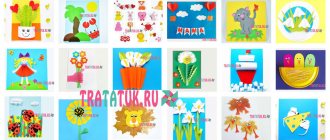How to organize a duty schedule?
Whatman paper can serve as the basis for organizing duty in kindergarten, creating a schedule and schedule. It is best to place photographs of the students on the sheet or assign each child his own symbol. This notation will be useful later. The line of duty can be arranged in alphabetical order of the children's surnames, if desired, or according to the principle of desks, the children at the first table are on duty first, and at the end of the month - the children at the last.
For good behavior, help and attentiveness, the child will receive a card at the end of duty. If, for example, the paper is red, it means that the child coped with his duties perfectly. If something didn’t work out during duty, the card may be a different color.
On whatman paper with your own kindergarten duty schedule, you can add small pockets under the photographs of the pupils, in which leaflets indicating the child’s achievements will be stored. Or you can do without photographs of children and put images of special symbols that would characterize the pupil directly into a special handbag.
For example, the duty officer chose a squirrel as his own symbol, and for successfully completed work, red cards with the image of a squirrel will appear in his pocket. This will mean that this particular student copes well with all tasks.
Thus, being on duty develops another trait in children - the ability to fantasize. After all, when creating a duty corner in a kindergarten with their own hands, students will be able to fully demonstrate their creative abilities, as well as when choosing a personal picture that will become a symbol of successful work.
Duty schedule: how to create
To maintain order and discipline, the teacher needs to think about how to introduce a duty schedule in kindergarten. This measure will help to count and take into account all the merits of the student and not get confused in the order. Such a schedule may look different, depending on the creative approach of the teacher. It is desirable that the pupils themselves take part in creating the duty corner. In this case, there will be a feeling of ownership of the innovation. Do-it-yourself work for duty can serve as an excellent start for uniting a children's team. In addition, each child will be able to put his own vision and show imagination, which is so necessary for creating a duty corner in kindergarten with his own hands.
Long-term planning of manual labor with older children
Week 4: Teamwork.
Theme: “Golden Autumn”.
Tasks:
Continue to teach children to use corrugated cardboard in their work.
To develop the ability to create plot compositions using various materials. Develop fine motor skills. Develop aesthetic perception. Cultivate perseverance, patience, and accuracy in work. Material:
Tinted sheet of A3 paper, strips.
November
Week 1: Team work.
Topic: “Flag of Russia.”
Tasks:
To develop in children the ability to work with napkins and glue.
Fix the colors of the Russian flag. Plan the progress of the work. Learn to place the image on the entire sheet. Develop fine motor skills. Cultivate interest in the activity. Materials:
cardboard, PVA glue, brushes. Napkins of white, blue, red colors, oilcloth.
Week 2: Topic: “A handkerchief doll.”
Tasks:
To develop children's ability to build a doll from a handkerchief.
Build independence and develop a sense of self-confidence. Foster independence. Develop hand motor skills. Material:
Handkerchief, cotton wool, thread.
Week 3: Topic: “Machine”.
Tasks:
Develop the ability to work with different materials (matchboxes).
Fix the rules for safe work with glue and scissors. Develop compositional skills. Cultivate the desire to finish what you start. Materials:
Colored paper, 3 matchboxes for each child, PVA glue, tassels, oilcloth.
Week 4: Topic: “Little Man”.
Tasks:
Teach the rules of safe work with acorns and matches. Develop compositional skills. Cultivate the desire to finish what you start. Develop imagination, fantasy, fine motor skills. Achieve accurate and high-quality work.
Material:
acorns, plasticine.
December
Week 1: Topic: “Rowan branch.”
Tasks:
To develop children’s ability to work with different materials (napkins) and plan their work.
Fix the signs of winter. Develop fine motor skills and perseverance. Cultivate the desire to finish what you start. Materials:
cardboard, stencil, white, red napkin, PVA glue, brush, oilcloth.
Week 2: Topic: “Bullfinch”.
Tasks:
To develop children’s ability to work with cereals and glue.
Plan the progress of the work. Strengthen the ability to place an image on the entire sheet. Develop fine motor skills. Cultivate interest in the activity. Materials:
cardboard, stencil, PVA glue, brush, painted millet, oilcloth.
Week 3: Topic: “Snowflake”.
Tasks:
Teach children to work with different materials (semolina) Teach safety rules for working with glue and cereals.
Learn to plan your work. Develop fine motor skills and perseverance. Cultivate the desire to finish what you start. Materials:
semolina, cardboard, stencil, PVA glue, brush, oilcloth.
Benefits of being on duty
Thanks to duty, the child begins to bear responsibility for the assignment. Even if the task is quite simple, being on duty in a kindergarten will develop a love of work. After all, the baby will be very pleased when, thanks to his own efforts, it becomes, for example, cleaner.
Based on such life experience, the child will subsequently perform duty tasks with greater concentration and dedication.




